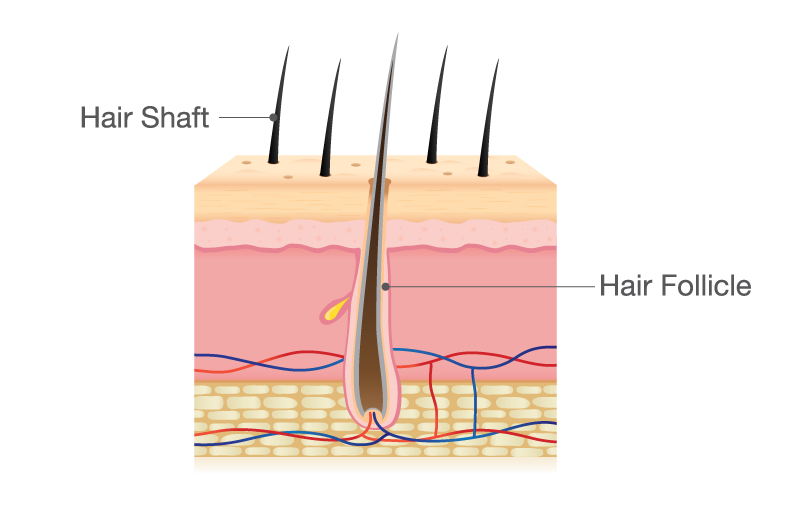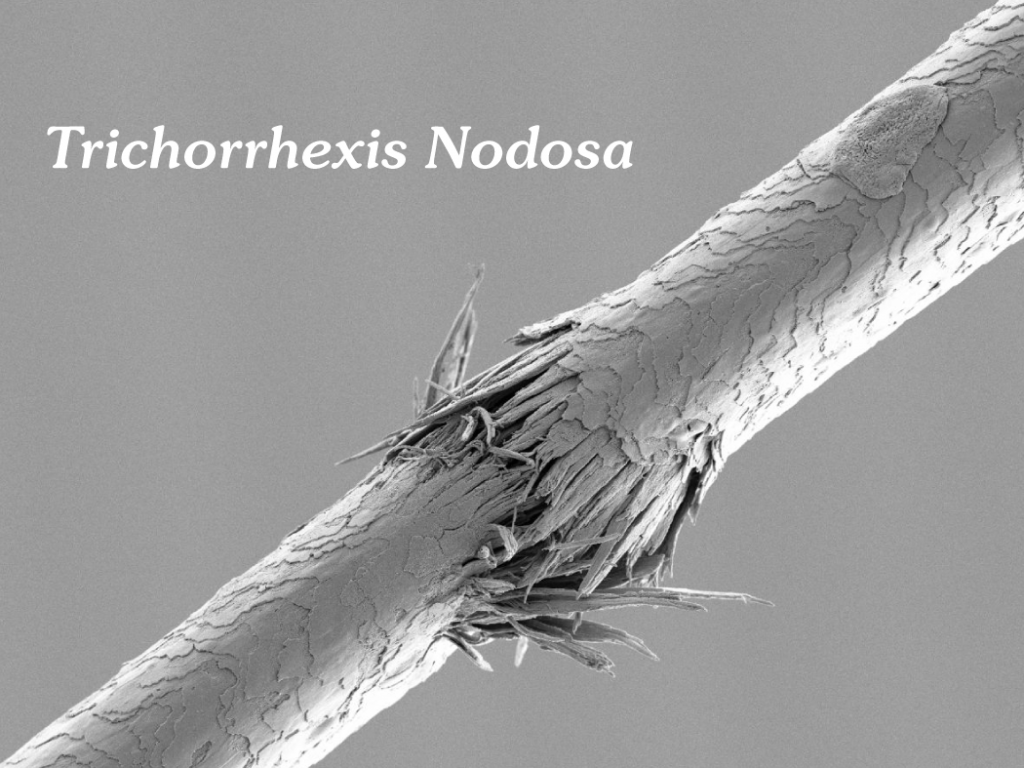Understand Hair Shaft defects - Causes, Symptoms & Solutions
Hair fracture? How can you possibly fracture your hair?!
Sounds crazy? It may sound fairly off, but yes...your hair can indeed get fractured!
We are referring to hair shaft defects. Hair shaft defects or hair shaft disorders, are quite common and are indicative of underlying pathology. This is something that you cannot self-diagnose at home. It is a condition that needs professional diagnosis and tricho-care accordingly.
As we always say, when you know the root problem, you can treat it appropriately and control it in the long term. And with conditions such as this, professional expertise and intervention are much needed.
Today, we will break this topic down in simple terms and help you understand what these hair defects are, what Trichorrhexis Nodosa is and how it is to be treated.
What is Hair Shaft?
Hair is an appendage of a layer of skin called the epidermis (the outer layer). It consists of two distinct parts namely the hair follicle and the hair shaft.
 Hair follicle is the basic unit for the generation of hair. The Hair shaft, simply put, is the hair strand that is visible to you above your scalp. It consists of a cortex, cuticle cells, and a medulla. It is made of a protein called keratin that is compacted and fused together. The keratin protein consists of amino acids that are connected together by a polypeptide chain known as the alpha helix (bound together by chemical bonds).
Do read our blog on hair anatomy to understand the hair structure and composition.
What are Hair Shaft Defects?
Hair shaft disorders or defects are quite a diverse group of abnormalities of the hair shaft that could be congenital or acquired. While some of these disorders cause hair shaft fragility, leading to increased hair breakage; others may alter the appearance or texture of your hair, though it may not be as fragile.
When examined clinically, structural changes in the hair shaft can be a part of a bouquet of symptoms. Changes in hair shaft over a large area of scalp can cause conditions like alopecia, frizzy woolly hair or at times may go completely undetected unless examined microscopically. As mentioned above, it is not something that you can diagnose and treat yourself!
Some of the known hair shaft disorders, in brief, are as under:
Hair follicle is the basic unit for the generation of hair. The Hair shaft, simply put, is the hair strand that is visible to you above your scalp. It consists of a cortex, cuticle cells, and a medulla. It is made of a protein called keratin that is compacted and fused together. The keratin protein consists of amino acids that are connected together by a polypeptide chain known as the alpha helix (bound together by chemical bonds).
Do read our blog on hair anatomy to understand the hair structure and composition.
What are Hair Shaft Defects?
Hair shaft disorders or defects are quite a diverse group of abnormalities of the hair shaft that could be congenital or acquired. While some of these disorders cause hair shaft fragility, leading to increased hair breakage; others may alter the appearance or texture of your hair, though it may not be as fragile.
When examined clinically, structural changes in the hair shaft can be a part of a bouquet of symptoms. Changes in hair shaft over a large area of scalp can cause conditions like alopecia, frizzy woolly hair or at times may go completely undetected unless examined microscopically. As mentioned above, it is not something that you can diagnose and treat yourself!
Some of the known hair shaft disorders, in brief, are as under:
 The condition basically leads to hair being & looking damaged, lack of hair growth and eventually, hair loss. It can be inherited/ congenital or acquired. Of the two, the acquired kind is more common. It is most often observed due to weathering from physical, mechanical or chemical causes. It tends to be distal (away from the root), where the weathering is most.
TN is characterised by the formation and presence of nodules along the hair shaft, which leads to hair that is very prone to breakage. When the condition spreads over a large area, it leads to alopecia.
When examined under the microscope, TN features little cracks on the hair shaft, from which several fibres emerge that resemble two brushes pushed against each other in the opposite direction. The nodules are whitish-yellow in colour and are randomly distributed along the hair shaft. They make the hair frail and prone to break easily.
As mentioned, this defect can also be hereditary (though it is mostly acquired) and the condition manifests within the first year of the affected infants being born. It is inherited in an autosomal dominant fashion.
What causes Trichorrhexis Nodosa (TN)?
TN is mainly caused by certain underlying disorders, even some rare ones, such as (not exhaustive),
The condition basically leads to hair being & looking damaged, lack of hair growth and eventually, hair loss. It can be inherited/ congenital or acquired. Of the two, the acquired kind is more common. It is most often observed due to weathering from physical, mechanical or chemical causes. It tends to be distal (away from the root), where the weathering is most.
TN is characterised by the formation and presence of nodules along the hair shaft, which leads to hair that is very prone to breakage. When the condition spreads over a large area, it leads to alopecia.
When examined under the microscope, TN features little cracks on the hair shaft, from which several fibres emerge that resemble two brushes pushed against each other in the opposite direction. The nodules are whitish-yellow in colour and are randomly distributed along the hair shaft. They make the hair frail and prone to break easily.
As mentioned, this defect can also be hereditary (though it is mostly acquired) and the condition manifests within the first year of the affected infants being born. It is inherited in an autosomal dominant fashion.
What causes Trichorrhexis Nodosa (TN)?
TN is mainly caused by certain underlying disorders, even some rare ones, such as (not exhaustive),
 Hair follicle is the basic unit for the generation of hair. The Hair shaft, simply put, is the hair strand that is visible to you above your scalp. It consists of a cortex, cuticle cells, and a medulla. It is made of a protein called keratin that is compacted and fused together. The keratin protein consists of amino acids that are connected together by a polypeptide chain known as the alpha helix (bound together by chemical bonds).
Do read our blog on hair anatomy to understand the hair structure and composition.
What are Hair Shaft Defects?
Hair shaft disorders or defects are quite a diverse group of abnormalities of the hair shaft that could be congenital or acquired. While some of these disorders cause hair shaft fragility, leading to increased hair breakage; others may alter the appearance or texture of your hair, though it may not be as fragile.
When examined clinically, structural changes in the hair shaft can be a part of a bouquet of symptoms. Changes in hair shaft over a large area of scalp can cause conditions like alopecia, frizzy woolly hair or at times may go completely undetected unless examined microscopically. As mentioned above, it is not something that you can diagnose and treat yourself!
Some of the known hair shaft disorders, in brief, are as under:
Hair follicle is the basic unit for the generation of hair. The Hair shaft, simply put, is the hair strand that is visible to you above your scalp. It consists of a cortex, cuticle cells, and a medulla. It is made of a protein called keratin that is compacted and fused together. The keratin protein consists of amino acids that are connected together by a polypeptide chain known as the alpha helix (bound together by chemical bonds).
Do read our blog on hair anatomy to understand the hair structure and composition.
What are Hair Shaft Defects?
Hair shaft disorders or defects are quite a diverse group of abnormalities of the hair shaft that could be congenital or acquired. While some of these disorders cause hair shaft fragility, leading to increased hair breakage; others may alter the appearance or texture of your hair, though it may not be as fragile.
When examined clinically, structural changes in the hair shaft can be a part of a bouquet of symptoms. Changes in hair shaft over a large area of scalp can cause conditions like alopecia, frizzy woolly hair or at times may go completely undetected unless examined microscopically. As mentioned above, it is not something that you can diagnose and treat yourself!
Some of the known hair shaft disorders, in brief, are as under:
- Trichorrhexis Nodosa (TN)Trichorrhexis nodosa is a commonly occurring abnormality of the hair shaft. It is characterised by the presence of nodules in the hair strand that cause hair breakage and alopecia.
- TrichoclasisTrichoclasis (“greenstick” fracture of the hair shaft) is a transverse fracture, splinted, by an intact cuticle. In this condition, no constant abnormality of the cuticle or cortex is observed.
- TrichoptilosisThis refers to the is the longitudinal splitting of the hair shaft or split ends. Rigorous brushing or physical and chemical trauma can result in Trichoptilosis. The cuticular loss from weathering causes the condition. The cortical fibres separate like the frayed ends of a rope giving rise to “split ends” or “frizzies”. Trichoptilosis is a fairly common fracture arising from trauma.
- PseudomonilethrixWith this condition, irregular beading or nodes is observed along the hair shaft. The beaded-appearance is caused by the expansion of the normal hair shaft, due to indentation and/or flattening. Pseudomonilethrix can lead to fragility and breakage of hair resulting in partial baldness.
- Trichonodosis‘Knotting of hair’ is the common term for this condition, as is the symptom. Seen more often in curly hair, this condition can either be genetic or acquired due to trauma. It does not bear any clinical significance.
- TrichoschisisThis refers to a clean transverse break across the hair shaft. It is known to arise due to the absence of the cuticle in the affected area. It is usually seen in congenitally brittle hair, with low-sulfur content.
- Trichorrhexis Invaginata (Bamboo Hair)Bamboo Hair, as it is commonly known, is a distinctive hair shaft abnormality that may occur sporadically, either in normal hair, or with other hair shaft abnormalities, or regularly as a marker for Netherton’s syndrome.
- Oblique Fractures - Tapered FractureThis condition causes a pencil-point appearance. This is due to the inhibition of nucleic acid and protein synthesis leading to mitosis (cell-division - simple duplication of a cell and all of its parts) during the anagen phase.
- TrichomalaciaTrichomalacia is the hair shaft damage that occurs on the underlying anagen hair, from repeated hair plucking or pulling. It is most commonly seen in those suffering from trichotillomania.
- Green HairThis condition is always associated with copper in the hair in some form and tends to affect bleached hair. It may be a result of over-exposure to swimming pool water, where chloride treatment or copper algaecides are used. It may also stem from high levels of copper in domestic water pipes.
- Bubble HairThis is when the cross-section of the hair shaft shows rows of bubbles within it. It is associated with highlighting hair and frequent use of hair blow dryers. It is said to be caused by the focussed heating of damp hair. This can produce bubbles within the hair shaft, resulting in the hair fibres becoming dry and brittle.
 The condition basically leads to hair being & looking damaged, lack of hair growth and eventually, hair loss. It can be inherited/ congenital or acquired. Of the two, the acquired kind is more common. It is most often observed due to weathering from physical, mechanical or chemical causes. It tends to be distal (away from the root), where the weathering is most.
TN is characterised by the formation and presence of nodules along the hair shaft, which leads to hair that is very prone to breakage. When the condition spreads over a large area, it leads to alopecia.
When examined under the microscope, TN features little cracks on the hair shaft, from which several fibres emerge that resemble two brushes pushed against each other in the opposite direction. The nodules are whitish-yellow in colour and are randomly distributed along the hair shaft. They make the hair frail and prone to break easily.
As mentioned, this defect can also be hereditary (though it is mostly acquired) and the condition manifests within the first year of the affected infants being born. It is inherited in an autosomal dominant fashion.
What causes Trichorrhexis Nodosa (TN)?
TN is mainly caused by certain underlying disorders, even some rare ones, such as (not exhaustive),
The condition basically leads to hair being & looking damaged, lack of hair growth and eventually, hair loss. It can be inherited/ congenital or acquired. Of the two, the acquired kind is more common. It is most often observed due to weathering from physical, mechanical or chemical causes. It tends to be distal (away from the root), where the weathering is most.
TN is characterised by the formation and presence of nodules along the hair shaft, which leads to hair that is very prone to breakage. When the condition spreads over a large area, it leads to alopecia.
When examined under the microscope, TN features little cracks on the hair shaft, from which several fibres emerge that resemble two brushes pushed against each other in the opposite direction. The nodules are whitish-yellow in colour and are randomly distributed along the hair shaft. They make the hair frail and prone to break easily.
As mentioned, this defect can also be hereditary (though it is mostly acquired) and the condition manifests within the first year of the affected infants being born. It is inherited in an autosomal dominant fashion.
What causes Trichorrhexis Nodosa (TN)?
TN is mainly caused by certain underlying disorders, even some rare ones, such as (not exhaustive),
- Hypothyroidism
- Argininosuccinic Aciduria - Build-up of ammonia in the body
- Netherton’s syndrome
- Menkes syndrome also known as the Menkes kinky hair syndrome
- Certain abnormal conditions such as abnormal development of the skin, hair, nails, teeth, or sweat glands (ectodermal dysplasia)
- Trichothiodystrophy - an inherited disorder that leads to brittle hair, skin problems, and even intellectual disability in some
- Malnutrition or endocrinopathy, especially iron deficiency
- Biotin deficiency - here referring to an inherited disorder, wherein the body is unable to use biotin productively.
- Excessive combing of hair
- Hair straightening and perming
- Blow-drying
- Frequent excessive brushing
- Aggressive scalp massage
- Backcombing constantly
- Stressed hairstyles where the hair is pulled very tight, straining the shafts,
- Excessive application of heat for styling - use of high temperatures
- Lengthy/ repeated ultraviolet exposure
- Head rolling and banging
- Habit tics like trichotillomania
- Scratching and pulling associated with pruritic dermatoses, such as seborrheic dermatitis and pediculosis capitis
- Excessive exposure to saltwater or chlorinated water
- Excessive use of shampoo
- Bleaching
- Frequent application of hair-permanent liquid, hair dyes
- Frequent use of hair sprays
- Use of chemical hair straighteners
- Use of selenium shampoo
- Patchy hair
- Dull and very brittle hair
- Hair breaks very easily
- Lack of hair growth
- Ends of the hair shaft are very thin and split
- Whitish discolouration of the tips
- Avoiding frequent use of styling equipment - Do not iron hair
- Avoiding chemical treatments
- Avoid aggressive brushing and grooming
- Avoid products with strong chemicals - hair straightening compounds, permanents, etc.
- Keep a check on hair-damaging habits.
- Eat a healthy and balanced diet - with due inputs from your Trichologist
- Drink ample water
- Following a regular hair care regimen of oiling, shampooing, washing, and conditioning
- User hair products approved by your trichologist for your hair condition. Do not use off-the-rack products.
- If your hair is prone to dryness, deep condition periodically
- If you colour frequently, get a detox tricho treatment done regularly.
- A visit to your Trichologist every 4-6 months.
